Ji Woo Hong
TARO: Timestep-Adaptive Representation Alignment with Onset-Aware Conditioning for Synchronized Video-to-Audio Synthesis
Apr 08, 2025Abstract:This paper introduces Timestep-Adaptive Representation Alignment with Onset-Aware Conditioning (TARO), a novel framework for high-fidelity and temporally coherent video-to-audio synthesis. Built upon flow-based transformers, which offer stable training and continuous transformations for enhanced synchronization and audio quality, TARO introduces two key innovations: (1) Timestep-Adaptive Representation Alignment (TRA), which dynamically aligns latent representations by adjusting alignment strength based on the noise schedule, ensuring smooth evolution and improved fidelity, and (2) Onset-Aware Conditioning (OAC), which integrates onset cues that serve as sharp event-driven markers of audio-relevant visual moments to enhance synchronization with dynamic visual events. Extensive experiments on the VGGSound and Landscape datasets demonstrate that TARO outperforms prior methods, achieving relatively 53\% lower Frechet Distance (FD), 29% lower Frechet Audio Distance (FAD), and a 97.19% Alignment Accuracy, highlighting its superior audio quality and synchronization precision.
ITA-MDT: Image-Timestep-Adaptive Masked Diffusion Transformer Framework for Image-Based Virtual Try-On
Mar 26, 2025Abstract:This paper introduces ITA-MDT, the Image-Timestep-Adaptive Masked Diffusion Transformer Framework for Image-Based Virtual Try-On (IVTON), designed to overcome the limitations of previous approaches by leveraging the Masked Diffusion Transformer (MDT) for improved handling of both global garment context and fine-grained details. The IVTON task involves seamlessly superimposing a garment from one image onto a person in another, creating a realistic depiction of the person wearing the specified garment. Unlike conventional diffusion-based virtual try-on models that depend on large pre-trained U-Net architectures, ITA-MDT leverages a lightweight, scalable transformer-based denoising diffusion model with a mask latent modeling scheme, achieving competitive results while reducing computational overhead. A key component of ITA-MDT is the Image-Timestep Adaptive Feature Aggregator (ITAFA), a dynamic feature aggregator that combines all of the features from the image encoder into a unified feature of the same size, guided by diffusion timestep and garment image complexity. This enables adaptive weighting of features, allowing the model to emphasize either global information or fine-grained details based on the requirements of the denoising stage. Additionally, the Salient Region Extractor (SRE) module is presented to identify complex region of the garment to provide high-resolution local information to the denoising model as an additional condition alongside the global information of the full garment image. This targeted conditioning strategy enhances detail preservation of fine details in highly salient garment regions, optimizing computational resources by avoiding unnecessarily processing entire garment image. Comparative evaluations confirms that ITA-MDT improves efficiency while maintaining strong performance, reaching state-of-the-art results in several metrics.
E-MD3C: Taming Masked Diffusion Transformers for Efficient Zero-Shot Object Customization
Feb 13, 2025Abstract:We propose E-MD3C ($\underline{E}$fficient $\underline{M}$asked $\underline{D}$iffusion Transformer with Disentangled $\underline{C}$onditions and $\underline{C}$ompact $\underline{C}$ollector), a highly efficient framework for zero-shot object image customization. Unlike prior works reliant on resource-intensive Unet architectures, our approach employs lightweight masked diffusion transformers operating on latent patches, offering significantly improved computational efficiency. The framework integrates three core components: (1) an efficient masked diffusion transformer for processing autoencoder latents, (2) a disentangled condition design that ensures compactness while preserving background alignment and fine details, and (3) a learnable Conditions Collector that consolidates multiple inputs into a compact representation for efficient denoising and learning. E-MD3C outperforms the existing approach on the VITON-HD dataset across metrics such as PSNR, FID, SSIM, and LPIPS, demonstrating clear advantages in parameters, memory efficiency, and inference speed. With only $\frac{1}{4}$ of the parameters, our Transformer-based 468M model delivers $2.5\times$ faster inference and uses $\frac{2}{3}$ of the GPU memory compared to an 1720M Unet-based latent diffusion model.
Zero-Shot Dual-Path Integration Framework for Open-Vocabulary 3D Instance Segmentation
Aug 16, 2024
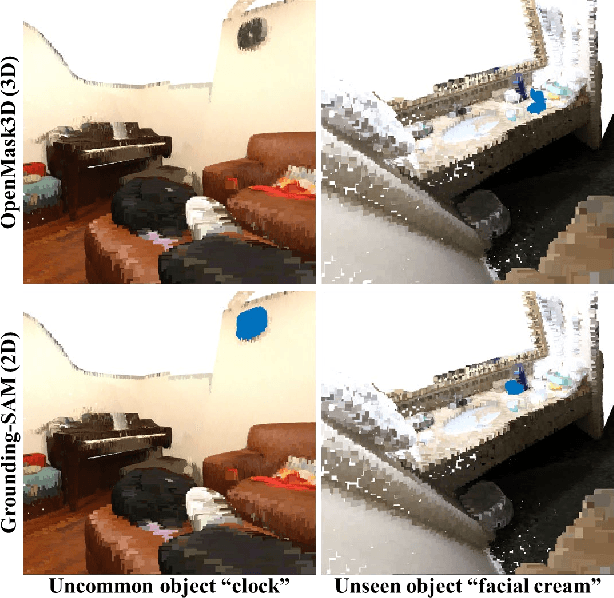

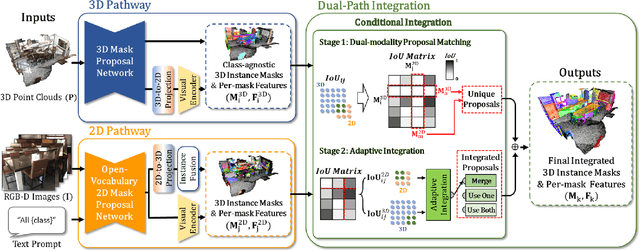
Abstract:Open-vocabulary 3D instance segmentation transcends traditional closed-vocabulary methods by enabling the identification of both previously seen and unseen objects in real-world scenarios. It leverages a dual-modality approach, utilizing both 3D point clouds and 2D multi-view images to generate class-agnostic object mask proposals. Previous efforts predominantly focused on enhancing 3D mask proposal models; consequently, the information that could come from 2D association to 3D was not fully exploited. This bias towards 3D data, while effective for familiar indoor objects, limits the system's adaptability to new and varied object types, where 2D models offer greater utility. Addressing this gap, we introduce Zero-Shot Dual-Path Integration Framework that equally values the contributions of both 3D and 2D modalities. Our framework comprises three components: 3D pathway, 2D pathway, and Dual-Path Integration. 3D pathway generates spatially accurate class-agnostic mask proposals of common indoor objects from 3D point cloud data using a pre-trained 3D model, while 2D pathway utilizes pre-trained open-vocabulary instance segmentation model to identify a diverse array of object proposals from multi-view RGB-D images. In Dual-Path Integration, our Conditional Integration process, which operates in two stages, filters and merges the proposals from both pathways adaptively. This process harmonizes output proposals to enhance segmentation capabilities. Our framework, utilizing pre-trained models in a zero-shot manner, is model-agnostic and demonstrates superior performance on both seen and unseen data, as evidenced by comprehensive evaluations on the ScanNet200 and qualitative results on ARKitScenes datasets.
FlexiEdit: Frequency-Aware Latent Refinement for Enhanced Non-Rigid Editing
Jul 25, 2024Abstract:Current image editing methods primarily utilize DDIM Inversion, employing a two-branch diffusion approach to preserve the attributes and layout of the original image. However, these methods encounter challenges with non-rigid edits, which involve altering the image's layout or structure. Our comprehensive analysis reveals that the high-frequency components of DDIM latent, crucial for retaining the original image's key features and layout, significantly contribute to these limitations. Addressing this, we introduce FlexiEdit, which enhances fidelity to input text prompts by refining DDIM latent, by reducing high-frequency components in targeted editing areas. FlexiEdit comprises two key components: (1) Latent Refinement, which modifies DDIM latent to better accommodate layout adjustments, and (2) Edit Fidelity Enhancement via Re-inversion, aimed at ensuring the edits more accurately reflect the input text prompts. Our approach represents notable progress in image editing, particularly in performing complex non-rigid edits, showcasing its enhanced capability through comparative experiments.
Neutral Editing Framework for Diffusion-based Video Editing
Dec 10, 2023Abstract:Text-conditioned image editing has succeeded in various types of editing based on a diffusion framework. Unfortunately, this success did not carry over to a video, which continues to be challenging. Existing video editing systems are still limited to rigid-type editing such as style transfer and object overlay. To this end, this paper proposes Neutral Editing (NeuEdit) framework to enable complex non-rigid editing by changing the motion of a person/object in a video, which has never been attempted before. NeuEdit introduces a concept of `neutralization' that enhances a tuning-editing process of diffusion-based editing systems in a model-agnostic manner by leveraging input video and text without any other auxiliary aids (e.g., visual masks, video captions). Extensive experiments on numerous videos demonstrate adaptability and effectiveness of the NeuEdit framework. The website of our work is available here: https://neuedit.github.io
Self-Supervised Visual Representation Learning via Residual Momentum
Nov 21, 2022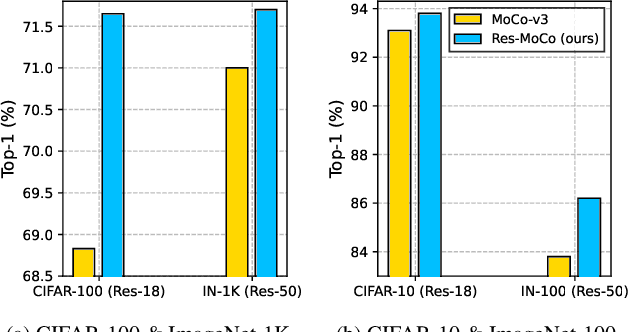
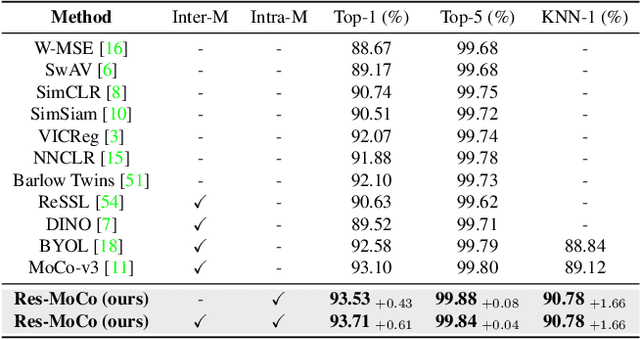
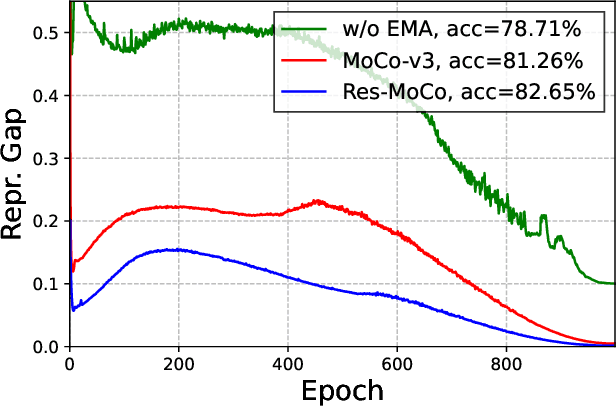
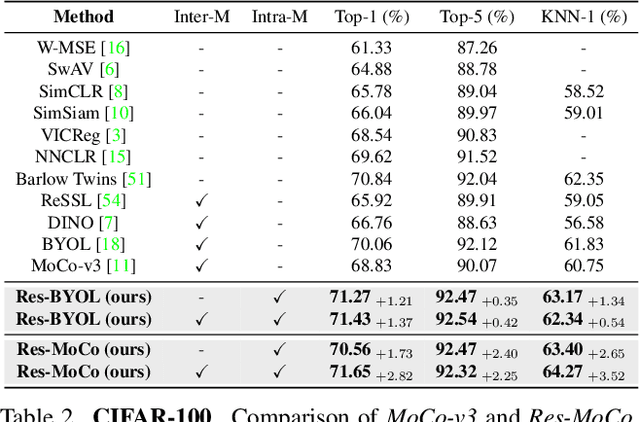
Abstract:Self-supervised learning (SSL) approaches have shown promising capabilities in learning the representation from unlabeled data. Amongst them, momentum-based frameworks have attracted significant attention. Despite being a great success, these momentum-based SSL frameworks suffer from a large gap in representation between the online encoder (student) and the momentum encoder (teacher), which hinders performance on downstream tasks. This paper is the first to investigate and identify this invisible gap as a bottleneck that has been overlooked in the existing SSL frameworks, potentially preventing the models from learning good representation. To solve this problem, we propose "residual momentum" to directly reduce this gap to encourage the student to learn the representation as close to that of the teacher as possible, narrow the performance gap with the teacher, and significantly improve the existing SSL. Our method is straightforward, easy to implement, and can be easily plugged into other SSL frameworks. Extensive experimental results on numerous benchmark datasets and diverse network architectures have demonstrated the effectiveness of our method over the state-of-the-art contrastive learning baselines.
Selective Query-guided Debiasing Network for Video Corpus Moment Retrieval
Oct 17, 2022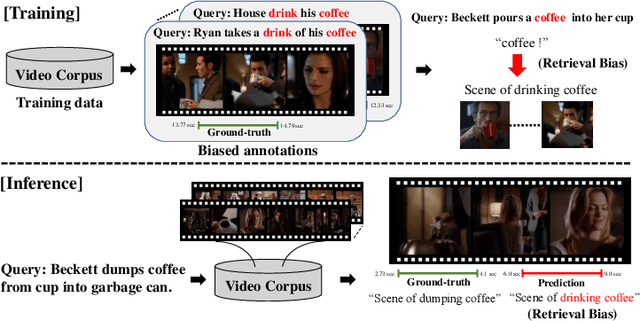
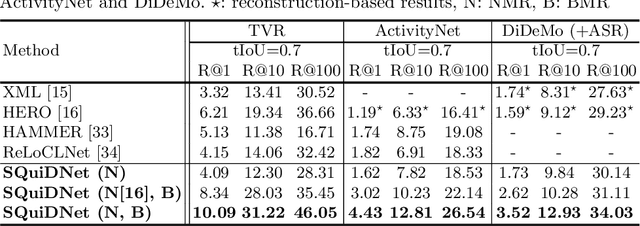
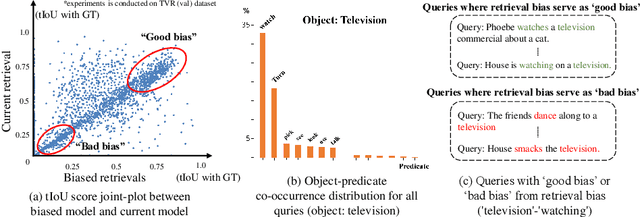

Abstract:Video moment retrieval (VMR) aims to localize target moments in untrimmed videos pertinent to a given textual query. Existing retrieval systems tend to rely on retrieval bias as a shortcut and thus, fail to sufficiently learn multi-modal interactions between query and video. This retrieval bias stems from learning frequent co-occurrence patterns between query and moments, which spuriously correlate objects (e.g., a pencil) referred in the query with moments (e.g., scene of writing with a pencil) where the objects frequently appear in the video, such that they converge into biased moment predictions. Although recent debiasing methods have focused on removing this retrieval bias, we argue that these biased predictions sometimes should be preserved because there are many queries where biased predictions are rather helpful. To conjugate this retrieval bias, we propose a Selective Query-guided Debiasing network (SQuiDNet), which incorporates the following two main properties: (1) Biased Moment Retrieval that intentionally uncovers the biased moments inherent in objects of the query and (2) Selective Query-guided Debiasing that performs selective debiasing guided by the meaning of the query. Our experimental results on three moment retrieval benchmarks (i.e., TVR, ActivityNet, DiDeMo) show the effectiveness of SQuiDNet and qualitative analysis shows improved interpretability.
 Add to Chrome
Add to Chrome Add to Firefox
Add to Firefox Add to Edge
Add to Edge